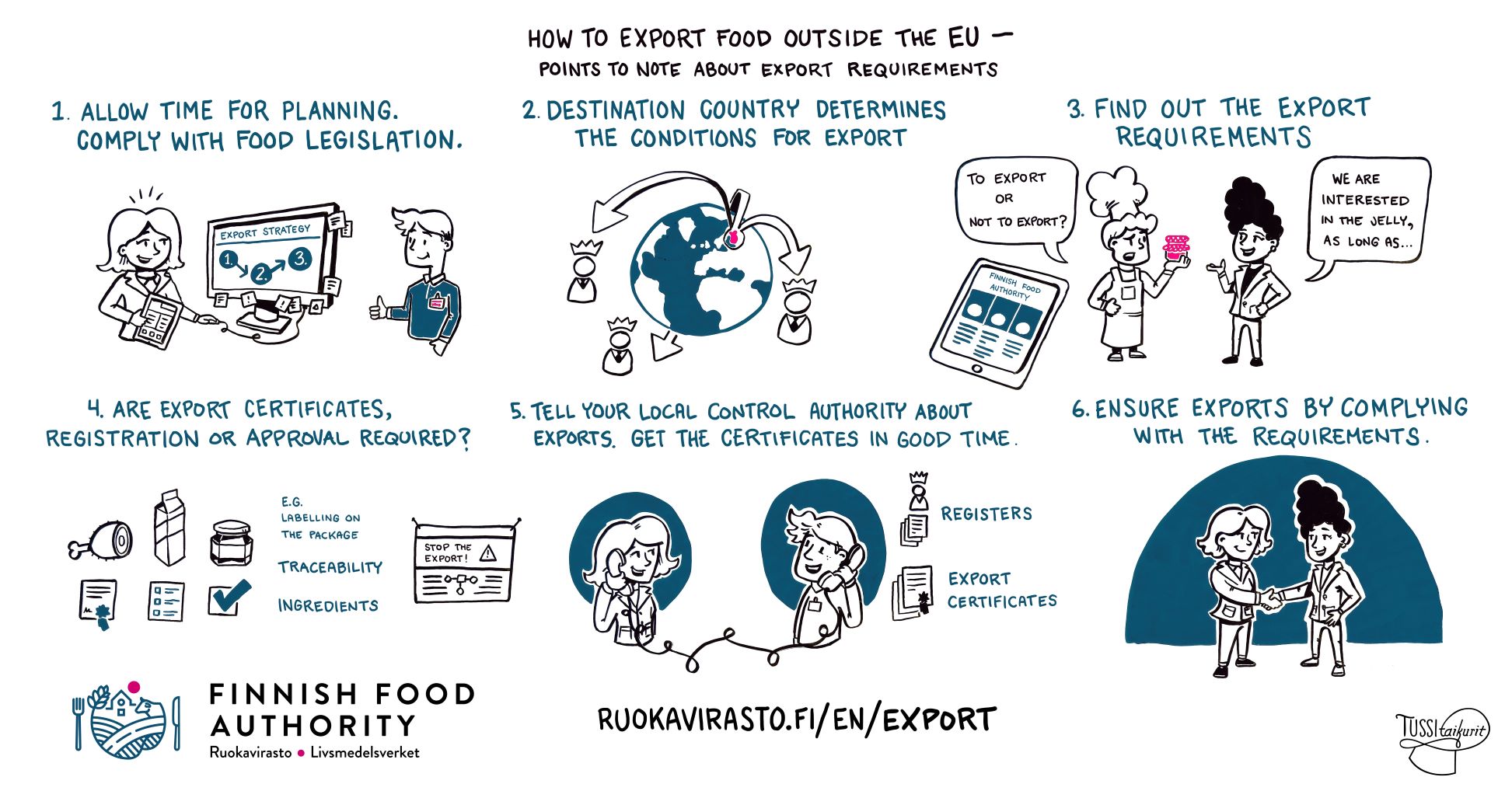Before the export: Assess the markets and familiarise yourself with the conditions
Countries outside the EU can set stricter requirements for your company and export products than our legislation calls for. Depending on the country of destination and the product it may be very easy to start exporting, but sometimes it will take years before you can get market access. Starting to export products of animal origin especially, may require that you apply for approval for your country and/or establishment from the authorities of the country of destination.
Sort out the requirements for your export products by the countries of destination and possibly countries of transit outside the EU well ahead of time! As an exporter you are legally responsible for working out what the requirements are and how to fulfil them – but remember that there is help available for this.
How to export food outside the EU - points to note about export requirements

From where can I find out what the export requirements are?
- On our product-specific websites and in our Kontti service (in Finnish) you will find the requirements we have knowledge of, listed by country of destination and by export product
- Also ask our experts for advice on the requirements
- From your trading partner in the country of destination
- From the authorities in the country of destination (from the food safety, animal and phytosanitary authorities or the customs authority for example)
- From Access2Markets of the European Commission (search on country and CN code)
- From the Market Entry Handbooks of the European Commission (available after logging in)
- From the Finnish missions and the Team Finland network
Also inform the control authority that you are starting an export operation and of the requirements you have researched so they can get acquainted with the requirements and ensure that they are being fulfilled. The Food Authority is involved in the demonstration of the fulfilment of the requirements of the country of destination if the country of destination requires for example clarification on the arrangements and activities of the Finnish food controls.
Starting to export: Take care of approvals, registrations and order certificates on time
- Make sure that your product fulfils the requirements set by the country of destination and that there are no obstacles to the export.
- Register with the necessary registers in Finland.
- Make sure that you are registered in any registers possibly required by the country of destination.
Acquire the export licences in good time. The control authority grants the export licences required by the country of destination. Send all documentation and information needed for the licence to the inspector, who then can grant the licence needed. The licences will accompany the export batches to the country of destination, where they are inspected in conjunction with the border procedures.
Contact our experts on exports if the authority of the country of destination requires:
- an agreement between the country of destination and Finland on the content and format of the export licence (e.g. a health certificate)
- registration of the facility manufacturing the export product, the loading place to be used for exports and/or registration of the exporter by the country of destination
- approval of the Finnish control system by the country of destination
- other measures related to food safety.
When exports continue: Monitor the business environment and adhere to agreed rules
Secure existing exports by adhering to the requirements set by the country of destination. Note, that for example a change in the situation concerning animal or plant diseases in Finland or the EU can affect the exports.
Remember that adhering to requirements can cause additional work both for production and for in-house controls and controls carried out by the authorities. It has to be possible to show the country of destination that the requirements set by that country are being adhered to in Finland.
EU and Finland have agreed on the export conditions with several individual countries of destination or groups of countries of destination. The agreements mainly deal with the safety of the products. Non-adherence to the conditions set out in the agreements could endanger all the exports from Finland. Our exports are as strong as their weakest link. Ensure you have the necessary expertise for exporting and that you play your part in the continuity of exports!
Importance of the origin of the product
The World Trade Organisation WTO wants to harmonise the concept of origin in international trade. The origin is, however, always determined according to the rules of origin set by the country of destination.
The trade policies, such as anti-dumping and countervailing duties, labelling of origin and potential safeguard measures are determined based on the origin of the product. Acquaint yourself with the rules of origin on the website of the European Commission.
The countries of destination may also set requirements on the origin of the primary production of the product. For example pork exported from Finland may be subjected to a condition that the pigs were born and raised in Finland. In that case it is not possible to for example export from Finland pork from pigs that were born and raised in Sweden to the country of destination.